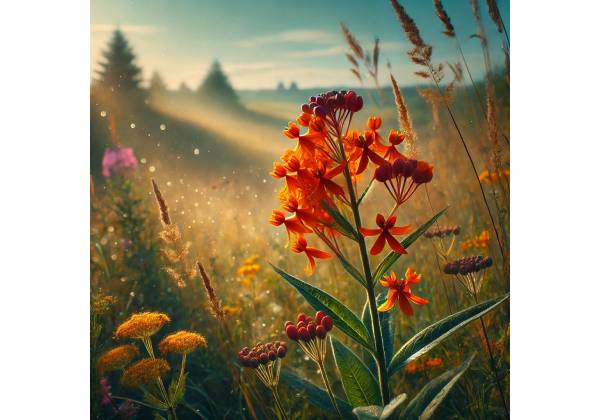Butterfly Weed (Asclepias tuberosa) is a bright, eye-catching perennial prized by gardeners and nature lovers across North America. Known for its stunning clusters of orange to reddish-orange blossoms, this native milkweed species offers more than just good looks. It’s a major magnet for pollinators—especially monarch butterflies—and has a history of use in certain folk remedies. While it isn’t the flashiest herbal superstar, many admire Butterfly Weed for its role in supporting pollinator habitats, for potential mild wellness applications, and for how it enriches gardens with bold color.
Belonging to the milkweed family (Apocynaceae), Butterfly Weed stands out for its unique taproot, hairy stems, and the milky, latex-like sap characteristic of milkweeds (though less abundant than in some relatives). In older herbal traditions, the plant was sometimes called “pleurisy root,” reflecting one of its folk uses in mild respiratory conditions. Today, it’s still widely cultivated for ornamental value and occasionally referenced for mild herbal support, albeit with caution about toxicity in raw or misused forms.
Below are some of the major benefits and features often associated with Butterfly Weed:
- Acts as a powerful pollinator plant, especially for monarch butterflies
- Historically tied to mild respiratory and digestive support
- Adds vibrant orange color to gardens and landscapes
- Promotes ecological diversity as a native milkweed species
- Contains certain cardiac glycosides and other active compounds
Table of Contents
- Botanical Profile and Identification: Distinguishing Butterfly Weed’s Key Traits
- The History and Heritage of Butterfly Weed Over Time
- Examining Butterfly Weed’s Phytochemistry and Active Components
- Butterfly Weed Health Benefits: How It May Assist Wellness
- Core Properties That Define Butterfly Weed’s Character
- Butterfly Weed Uses and Safety Guidelines to Keep in Mind
- Significant Studies and Research on Butterfly Weed
- Butterfly Weed FAQ
Botanical Profile and Identification: Distinguishing Butterfly Weed’s Key Traits
Recognizing Butterfly Weed in the wild or choosing it for your garden starts with understanding its hallmark features. While it shares some family traits with other milkweeds, its unique coloration and growth patterns set it apart.
Physical Description
- Flowers
- The showy clusters of bright orange or orange-red blossoms are arguably Butterfly Weed’s biggest draw. Blooms form an umbel shape and typically appear from late spring through summer.
- Each flower in the cluster sports five petals that curve downward and five upright “hoods,” creating a starburst effect. Pollinators find them irresistible—particularly bees, wasps, and monarch butterflies.
- Leaves
- Leaves are typically lanceolate (narrow and tapering at both ends), arranged alternately along the stem. They’re hairier and less “milky” than some other Asclepias species.
- Unlike Common Milkweed, Butterfly Weed stems do not exude copious latex sap when cut—though a small amount may be present.
- Stems and Height
- Plants generally reach between 1–3 feet in height, with multiple branching stems. The stems can have a slightly woody base, especially on more mature plants, and fine hairs that give them a fuzzy appearance.
- Root System
- Butterfly Weed develops a thick, somewhat woody taproot that helps it withstand drought conditions. This root structure can make transplanting mature specimens challenging.
Natural Range and Habitat
- Native Distribution
Butterfly Weed is found throughout much of the eastern and central United States. It typically grows in prairies, open woods, fields, and roadsides. - Soil and Sun
The plant flourishes in well-drained, sandy or loamy soils, preferring full sun. It tolerates moderate moisture levels but is notably drought-hardy thanks to that robust taproot.
Differentiating from Other Milkweeds
- Color
Most other milkweeds produce pinkish, purple, or white flowers. Butterfly Weed’s vivid orange is easy to spot. - Lack of Milky Sap
While many milkweeds exude a milky latex, the fluid is less prominent in Butterfly Weed. This helps confirm you’ve got the correct species if you see only a small sap bead after leaf or stem damage.
Cultivation Notes
- Seed Propagation
- Seeds are contained in spindle-shaped pods that open to release seeds with silky fibers. Sowing them requires patience; they benefit from cold stratification to improve germination rates.
- Maintenance
- Once established, it’s a low-maintenance perennial needing minimal watering. Deadheading spent blooms can encourage prolonged flowering or manage self-seeding if you prefer fewer volunteer plants.
Overall, Butterfly Weed’s distinctive orange flair, along with minimal sap and hairy stems, helps it stand out from its milky relatives. Whether you find it on a sunny roadside or nestling in a pollinator garden, its bright floral clusters and easy adaptability make it a beloved choice for those wanting both ecological value and aesthetic vibrancy.
The History and Heritage of Butterfly Weed Over Time
Butterfly Weed’s backstory intertwines indigenous uses, a role in early American herbal traditions, and an ongoing evolution as a hallmark pollinator plant. Whether recognized as “pleurisy root” or simply prized for its radiant blossoms, the plant has carved out a steady presence in horticulture and folklore.
Indigenous and Colonial Eras
- Native American Knowledge
- Various tribes across North America were aware of Butterfly Weed, tapping it for mild medicinal uses—particularly the root. Historical accounts suggest it was brewed into teas for respiratory or digestive discomfort.
- Because it’s part of the broader milkweed family, certain populations also recognized it as a meager source of fiber from the stems, though the main fiber source from the genus was typically Common Milkweed.
- Colonial Herbal Integration
- European settlers in America gradually learned from indigenous practices. They labeled the plant “pleurisy root” in recognition of folk usage for chest or lung concerns.
- Early apothecaries sold dried root or prepared tinctures, though usage never reached mainstream popularity like common herbs (chamomile, mint, etc.). Instead, it remained a niche remedy in certain pockets.
19th Century to Early 20th Century
- Eclectic Medicine
- During the 19th-century Eclectic movement—where practitioners blended indigenous knowledge with conventional methods—Butterfly Weed gained minor traction as a potential diaphoretic or mild expectorant. This was especially relevant for chest or bronchial conditions.
- Despite some inclusion in specialized references, it didn’t become a go-to herb nationwide, overshadowed by other more robust therapies.
- Gardening Scene
- Meanwhile, horticultural interest in Butterfly Weed blossomed. With the nation’s expansion west, seeds were shared or distributed in trade, letting gardeners incorporate this brilliant orange perennial into ornamental beds. Some references from the period highlight its tolerance of poor soils and dryness, making it perfect for pioneer homesteads.
Contemporary Revival
- Pollinator Awareness
- Modern ecological movements stress the significance of native plants for bees, butterflies, and other pollinators. Butterfly Weed soared in popularity as a “must-have” in pollinator gardens, especially to aid imperiled monarch populations.
- Because monarch larvae feed on milkweed species, planting Butterfly Weed helps sustain this iconic butterfly’s lifecycle.
- Niche Herbal Recognition
- Although overshadowed by mainstream herbs, some holistic circles appreciate Butterfly Weed for its old folk roles in mild respiratory relief. However, usage is approached with caution due to potential toxicity if overused or misapplied.
- Aesthetics and Cultivation
- For many, the lasting appeal is purely ornamental: the luscious, fiery orange clusters enliven any landscape. Coupled with easy care and dryness tolerance, it’s favored in cottage gardens and meadow plantings.
Global Outlook
- Spreading Abroad
As interest in pollinator-friendly or drought-hardy ornamentals grows worldwide, Butterfly Weed seeds are shipped or sold to enthusiastic gardeners beyond the U.S. This furthers its presence in other warm, temperate areas. - Research Evolution
While not the subject of as many studies as mainstream botanical stars, curiosity about Asclepias tuberosa remains. Potential new uses or clarifications on its historical ones may shape future discussions, although it’s not currently in widespread commercial herbal production.
Ultimately, Butterfly Weed’s story echoes that of many lesser-known native plants: recognized early by indigenous peoples, partially absorbed into colonial herb lore, overshadowed through the industrial era, and then rediscovered in modern times as an ecologically and visually valuable species. Its ongoing legacy merges environmental stewardship (pollinators, dryness tolerance) with a dash of historical herbal interest, ensuring it stands out as more than just another bright flower in the garden.
Examining Butterfly Weed’s Phytochemistry and Active Components
Part of what piques interest about Butterfly Weed is the possibility that it harbors beneficial compounds—particularly in its roots. While research on Asclepias tuberosa is not as extensive as in mainstream herbs, known constituents tie in with some of the mild medicinal roles ascribed to it over time.
1. Cardiac Glycosides
- Presence in Milkweeds
Many milkweed species contain cardenolides (a type of cardiac glycoside), which can affect heart function if ingested in high amounts. In Butterfly Weed, these glycosides are typically less concentrated than in other Asclepias species. - Caution
While mild usage might not pose a significant threat, ingesting large quantities of raw plant parts could be toxic. This underscores the need for prudent handling if exploring any folk remedies.
2. Flavonoids
- Potential Protective Effects
Preliminary tests on milkweed family plants generally find a range of flavonoids that can act as antioxidants or support other protective roles. Though the specific profile for Asclepias tuberosa remains under-documented, it likely includes some helpful polyphenols. - Coloration
While the brilliant orange hue is primarily related to carotenoid pigments in the flowers, flavonoids could also factor into the subtle color variations from orange to deep red.
3. Resins and Volatile Components
- Aromatic Resins
Some references mention that the dried root can contain trace resin or aromatic substances, which might partially explain older usage for chest comfort or as a mild expectorant. - Minimal Essential Oil
It’s not typically used for essential oil extraction, and if any volatile oils exist, they are minimal and overshadowed by more potent aromatics in other plants.
4. Tannins
- Astringent Edge
Tannin presence can lead to mild astringency, helpful in small ways for digestive or external usage. However, data are scant on the exact tannin percentage in Butterfly Weed compared to other astringent herbs.
5. Proteins and Carbohydrates in the Roots
- Taproot Composition
The thick taproot might store certain sugars or starches, though it’s not recognized as a root vegetable for consumption (like carrots). Instead, any carbohydrate content is overshadowed by the presence of potential glycosides.
6. Variation with Growth Stage
- Seasonal Shifts
Concentrations of some compounds can fluctuate as the plant moves from flowering to seed-setting. Older herbal references often mention harvesting roots after the flowering stage for the strongest effect, though scientific backing is minimal.
Realistic Summation of Its Chemical Profile
Butterfly Weed’s chemical lineup, while not fully charted, suggests a typical Asclepias pattern with some beneficial flavonoids, mild astringents, and possibly a modest quantity of cardiac glycosides that demand caution. People historically banked on it for mild chest or respiratory support and as a diaphoretic or expectorant. Today, while that usage is less common, it’s still important to note that the presence of cardiac glycosides means ingesting large amounts raw is not advisable. For pollinator or ornamental usage, these chemical nuances pose little risk, but for any deeper forays into herbal usage, individuals must remain aware of the plant’s inherent complexity.
Butterfly Weed Health Benefits: How It May Assist Wellness
Even though Butterfly Weed is best known for brightening up meadows and feeding hungry butterflies, it also has a mild reputation for possible health advantages. Folks intrigued by local or historical herbs sometimes turn to its roots or aerial parts with an eye toward old folk applications—particularly around breathing comfort, mild chest support, or small digestive perks.
1. Possible Respiratory Support
- Traditional Chest Aid
The historical label “pleurisy root” emerges from older beliefs that the plant could help with chest issues, such as mild coughs or pleuritic discomfort. Some herbal references suggest that in moderate usage, the root might encourage normal lung function or gentle expectoration. - Expectorant Idea
By possibly loosening thick mucus, it might help someone with mild congestion. However, robust clinical trials aren’t readily available, so the usage remains rooted in anecdotal or historical contexts.
2. Mild Diaphoretic or Detox-Like Effect
- Stimulating Sweating
Some older texts say it can prompt subtle perspiration, supporting the body’s natural cleansing. This effect might tie in with the presence of certain glycosides or saponins. - Acute vs. Chronic
It might have been included in short-term regimens for colds or chills. But consistent or high doses risk toxicity, so caution is recommended if one tries to replicate these older regimens.
3. Potential Digestive Ease
- Folk Remedies
A few sources mention mild digestive help—like relieving minor bloating or gas. The mechanism is not well documented, though subtle spasmolytic or carminative properties might exist. - Limited Modern Validation
With so many safer, more proven digestive herbs (peppermint, fennel), reliance on Butterfly Weed in this arena is quite rare nowadays.
4. Skin or Topical Mentions
- Poultices
Some older rural communities used mashed or boiled leaves on small skin irritations or stings. This might revolve around slight anti-inflammatory or analgesic actions. - Modern Rarity
Because of the plant’s questionable internal safety at high doses, it’s not widely used in commercial creams or lotions. Instead, we see it mostly in ornamental or pollinator-friendly contexts.
5. Emotional or Symbolic Aspect
- Connection with Butterflies
While not a direct “benefit,” having Butterfly Weed in gardens fosters joy, pollinator sightings, and a sense of ecological harmony. Many find it uplifting to watch monarchs or other insects frequent the fiery orange blooms.
6. Realism about Potential
- Subtle, Not a Powerhouse
If you’re after big herbal power, other species might offer more potent or better-studied health support. Butterfly Weed’s mild usage is mostly tied to older traditions, limited anecdotal data, and the general concept of encouraging respiratory ease. - Complementary Approach
People exploring herbal solutions might combine it with more recognized herbs in formulas, but this is not as mainstream. Often, it’s overshadowed by robust chest or respiratory herbs like mullein or thyme.
Ultimately, for health-minded usage, the plant’s biggest “benefit” might be the intangible joy and ecological service it provides in gardens. If you want to harness it as an herbal ally, proceed carefully—acknowledging that historical references do exist but modern confirmation is lacking, and potential toxicity is a concern. In short, enjoy the color and pollinator support first, and handle any folk remedy angle with caution and possibly professional input.
Core Properties That Define Butterfly Weed’s Character
Butterfly Weed stands out among ornamental perennials for multiple reasons—vivid color, pollinator love, dryness tolerance, and mild herbal references. These properties combine to make it a must-have in certain native plant or wildlife-oriented landscapes.
1. Fiery Orange Blooms
- Visual Magnet
The bright, fiery flowers are its hallmark. In meadow or garden designs, this color pop can anchor a section, especially if you combine it with purples or blues for contrast. - Prolonged Flowering
Bloom times can span early to mid-summer, offering weeks of orange clusters that gradually shift in tone as they age.
2. Resilience to Heat and Drought
- Deep Taproot
The sturdy root system extracts water from deeper soil layers, letting the plant handle drier spells better than many ornamentals. This is beneficial for xeriscaping or low-water garden setups. - Limited Overwatering
On the flip side, too much water or poor drainage can cause root rot. Balanced watering is key, especially in the first season until roots establish.
3. Low Maintenance Approach
- Fertilizer
Generally needs no heavy fertilizing. A modest, organic blend or compost top-dressing once a year suffices. Over-fertilization might encourage leggy growth or reduce bloom intensity. - Pest Resistance
The milky latex and certain cardiac glycosides deter some pests, though occasionally aphids or snails might appear. Usually, beneficial insects handle small infestations well.
4. Pollinator Attraction
- Monarch Host
Like other milkweeds, it can serve as a host plant for monarch caterpillars. However, it’s less favored by monarchs compared to the common or swamp milkweed. Still, adult butterflies often come for the nectar. - Bees and Others
Bumblebees, honeybees, wasps, and pollinating flies also enjoy the rich nectar supply. Growing a patch can amplify pollinator activity in your garden.
5. Spreading Habit
- Seed Pods
Following the bright flowers, narrow pods form, eventually splitting to release seeds with silky fibers that carry them on the wind. If you let them scatter, new plants can pop up around your yard or beyond. - Managed Spread
If you want a tidier aesthetic, you can remove pods before they burst. Alternatively, let them ripen, collect seeds, and share them with fellow gardeners.
6. Light to Mild Aromatic Undertones
- Subtle Scent
Some report a faint sweet or musky note near large bloom clusters, but it’s nowhere near as fragrant as typical garden flowers like roses or lilacs. The main lure for pollinators is color and nectar, not fragrance.
7. Toxic Elements
- Cautionary Sides
Despite “Butterfly” in its name, the plant’s saps and seeds can be toxic if ingested by people or pets in large amounts. This is standard for many milkweeds but rarely a problem unless someone tries to eat large plant portions.
8. Cultural or Symbolic Value
- Ecological Good
Planting it can be seen as an ecological statement—helping reduce habitat loss for crucial pollinators. This aspect resonates with nature lovers and environmental stewards. - Landscape Visual
The bright color sets an emotional vibe—energetic, bold, and aligned with summertime cheer. In a wildflower patch or structured bed, it’s frequently the star attraction.
Overall, Butterfly Weed’s properties revolve around color, pollinator synergy, dryness resilience, and mild references to old-time usage. For most, the visual and ecological aspects overshadow any practical herbal approach, yet the combination of these traits cements its popularity in modern native landscaping.
Butterfly Weed Uses and Safety Guidelines to Keep in Mind
For many enthusiasts, the main uses of Butterfly Weed revolve around its ornamental and pollinator-friendly qualities. Some still highlight the plant’s old folk remedy angles, though caution is essential. Here’s a rundown of practical ways to incorporate it into your space or routine, along with guidelines to ensure you’re not stepping into risky territory.
1. Ornamental and Garden Uses
- Native Meadow or Prairie Gardens
- Butterfly Weed looks stunning in mass plantings, especially interspersed with grasses or other wildflowers (like coneflowers, black-eyed susans).
- Because it thrives in well-drained, sunny spots, it suits rock gardens, slopes, or the edges of a wildflower bed.
- Borders and Mixed Beds
- Pair the orange blooms with purple salvia or deep-blue lobelia for a color contrast. The upright form can stand in mid-border, giving an accent of vibrant hue.
- Container Growing
- If your region is too cold or you have limited yard space, consider a large container. Just ensure a deep pot for the taproot, decent drainage, and direct sun for best blooms.
2. Pollinator Support
- Monarch and Bee Haven
Planting Butterfly Weed contributes to the “milkweed corridor” that helps monarch populations on their migratory paths. Even though Asclepias tuberosa is less favored by monarch larvae than other milkweeds, it still offers nectar for adult monarchs. - Minimal Maintenance
Once established, your bed or container basically runs on autopilot. Water during extreme drought, deadhead if desired, and otherwise let pollinators do their thing.
3. Traditional or Folk Medicine
- Limited Modern Usage
- Historically, the root was used as “pleurisy root” in certain mild respiratory or “anti-inflammatory” contexts. But in contemporary herbal practice, it’s overshadowed by better-studied herbs.
- Potential Risk
- Raw ingestion can be risky due to the presence of cardiac glycosides. If you or someone else is curious about these old uses, it’s wise to consult an herbalist or medical professional first.
4. Dried Arrangements or Crafts
- Cut Flowers
You can harvest the bright heads for informal bouquets, but the color may fade as they dry. If you cut them fresh, remove lower leaves and place in a vase with water. - Dried Seed Pods
Some crafters incorporate the pods in fall or winter wreaths. They can add an interesting shape, though they might open and release seeds if kept in a warm spot.
5. Interaction with Pets and Children
- Toxic Concerns
If you have curious pets or small children who might nibble on garden plants, keep them away from ingesting any part of Butterfly Weed. The milky sap can irritate, and the glycosides can cause cardiac issues if eaten in larger amounts. - Fences or Protective Measures
Generally, the plant’s bitterness and minimal latex deter much munching. Still, caution is always prudent.
6. Harvesting and Seed Saving
- Seed Pod Maturation
- Seeds develop in elongated pods. Wait until they turn brown and start to split on their own, revealing silky fibers.
- Drying
- Gently remove seeds before they blow away in the wind. Spread them on paper to finish drying, then store in envelopes in a cool, dry space if you plan to replant or share.
7. Potential Overuse or Abuse
- Unproven Herbal Exaggerations
Avoid online claims that push the plant as a broad-spectrum cure. While it has historical ties, it’s not a widely validated medicinal powerhouse. Overconsumption can be detrimental. - Supplement Caution
Rarely do you see official “Butterfly Weed supplements.” If you do come across them, ensure they come from reputable suppliers who address potential toxicity. Nonetheless, such supplements are not standard in mainstream herbal commerce.
Ultimately, the best way to use Butterfly Weed for most people is as a vibrant, ecologically beneficial perennial that invites pollinators and brightens the yard. If you’re also drawn to its folk medicine past, proceed with caution—there’s a reason modern references rarely place it front and center as a herbal remedy. By respecting its potential hazards and focusing on environmental or aesthetic virtues, you’ll get the most out of this engaging milkweed cousin.
Significant Studies and Research on Butterfly Weed
Although it doesn’t hold the same prominent place in scientific literature as widely commercialized herbs, Butterfly Weed has popped up in scattered studies—especially in ecological research focusing on pollinators. Some ethnobotanical works also look at its historical usage. Below are some glimpses into the academic or practical investigations around Asclepias tuberosa.
1. Pollinator and Monarch Studies
- Habitat Contribution
Multiple ecological papers, such as a 2016 Ecological Restoration article, have documented how planting Butterfly Weed in restoration sites helps monarch populations. While Asclepias syriaca (Common Milkweed) remains the monarch staple, the presence of Butterfly Weed can diversify nectar sources. - Behavioral Observations
Field notes from pollinator biodiversity projects highlight that while Monarch caterpillars rarely feed on Butterfly Weed leaves, adult butterflies regularly visit the flowers for nectar. Bees and wasps also appear in large numbers during peak bloom.
2. Ethnobotanical and Historical Overviews
- Native American Usage
A 2008 monograph in the Journal of Ethnobiology documented multiple tribes referencing the plant for chest or bowel concerns, emphasizing dried root decoctions. Interviews with tribal elders confirmed the usage was sporadic and overshadowed by more commonly employed plants. - Colonial Herbal Mentions
Some compendiums from 18th-19th centuries, reprinted in modern times, refer to “pleurisy root” as a mild diaphoretic or expectorant. They caution about potential toxicity if overused, mirroring modern disclaimers.
3. Toxic and Pharmacological Investigations
- Cardiac Glycosides
A 1975 Planta Medica piece identified some glycosides in Asclepias tuberosa, though in smaller amounts than in other milkweeds. The study concluded that while not as lethal, ingestion could still pose issues for certain animals. - Potential Medicinal Value
Other older lab tests looked at anti-inflammatory or spasmolytic properties but lacked robust follow-up. Minimal new research has emerged to confirm strong medicinal viability.
4. Horticultural Science
- Cultivation and Breeding
Some horticultural studies revolve around best practices for seed germination or variation in flower color from bright orange to a deeper tangerine shade. A 2010 trial in HortScience found that cold stratification enhanced germination rates significantly. - Invasive Potential
Generally not labeled as invasive, but a few local agricultural bulletins mention self-seeding in field margins. However, the public outcry typically focuses on other, more aggressive species.
Butterfly Weed FAQ
Can I grow Butterfly Weed in a container?
Yes, Butterfly Weed can adapt to container life if the pot is deep enough to accommodate its taproot. Ensure proper drainage and place it in a sunny spot. Water moderately but avoid waterlogging. Once it’s established, it’s relatively low-maintenance, although it may not reach the same size as in open ground.
Is Butterfly Weed safe to touch or handle?
Generally, brushing against the leaves or flowers poses no major risk—though latex in the stems can irritate sensitive skin. Gloves aren’t strictly necessary for casual handling, but if you plan to harvest seeds or cut stems, wearing them is wise to avoid potential sap contact.
Are all milkweed species good for monarch butterflies?
Many Asclepias species support monarchs. Adult monarchs drink nectar from multiple milkweeds, and the larvae feed on the leaves. Butterfly Weed offers nectar for adult monarchs but is less frequently used for larval feeding compared to Common or Swamp Milkweed. Still, it’s a helpful addition to a monarch-friendly garden.
Can I use Butterfly Weed for respiratory ailments as recommended in old remedies?
If you’re curious about the folk practice of using “pleurisy root,” note that ingestion can be risky due to possible toxicity, especially if used incorrectly. There’s minimal modern evidence supporting strong respiratory benefits. Anyone considering it should consult a qualified herbalist or healthcare provider first.
Disclaimer
This article is for educational purposes and is not a substitute for professional medical advice. Always consult a qualified healthcare professional before making changes to your health routine, especially regarding any herb with potential toxicity.
If you enjoyed learning about Butterfly Weed, feel free to share this article on Facebook, X (formerly Twitter), or whichever social networks you love. Spreading the word might help someone else discover how this bold orange beauty can brighten their garden and support pollinators!

















